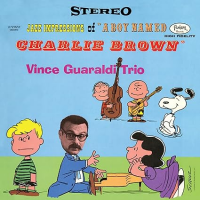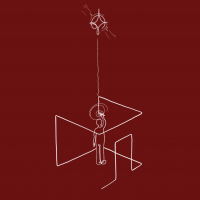Home » Jazz Musicians » Vince Guaraldi
Vince Guaraldi
By Derrick Bang
Like most so-called overnight successes, Vincent Anthony Guaraldi—who forever described himself as "a reformed boogie-woogie piano player"—worked hard for his big break.
The man eventually dubbed "Dr. Funk" by his compatriots was born in San Francisco on July 17, 1928; he graduated from Lincoln High School and then San Francisco State College. Guaraldi began performing while in college, haunting sessions at the Black Hawk and Jackson's Nook, sometimes with the Chubby Jackson / Bill Harris band, other times in combos with Sonny Criss and Bill Harris. He played weddings, high school concerts, and countless other small-potatoes gigs.
His first serious booking came at the Black Hawk, when he worked as an intermission pianist ... filling in for the legendary Art Tatum. "It was more than scary", Guaraldi later recalled. "I came close to giving up the instrument, and I wouldn't have been the first after working with Tatum". Guaraldi's first recorded work can be heard on "Vibratharpe", a 1953 release by the Cal Tjader. Guaraldi then avoided studios for the next few years, preferring to further hone his talents in the often unforgiving atmosphere of San Francisco's beatnik club scene. In 1955 he put together his own trio — longtime friend Eddie Duran on guitar, Dean Reilly on bass — and tackled North Beach's bohemian hungry i club. He also returned to studio work that year, making his recorded debut as group leader, although with different personnel: John Markham (drums), Eugene Wright (bass) and Jerry Dodgion (alto sax). What soon came to be recognized as the "Guaraldi sound", however, resulted from several recording sessions with his hungry i buddies. The original Vince Guaraldi Trio, with Duran and Reilly, can be heard on two releases: "The Vince Guaraldi Trio" (1956) and "A Flower is a Lonesome Thing" (1957)
Read moreTags
Vince Guaraldi’s Christmas Sauce: Adding Spice to Charlie Brown Vanilla

by Arthur R George
It's not simply that pianist Vince Guaraldi slipped jazz past the unsuspecting in composing A Charlie Brown Christmas, the evergreen “Peanuts" animation and soundtrack that has become inescapably part of the holiday. First broadcast in 1965, going on to six decades ago, A Charlie Brown Christmas is a tradition unto itself. It returns to television through PBS and PBS Kids on the evening of Sunday, December 19. Some who can't wait, or want to watch and listen again and again, ...
Continue ReadingBest Jazz Christmas Songs Of All-Time

by Ken Hohman
While moldy Christmas songs and great jazz seem as compatible as egg nog and Tanqueray, there have been instances where the planets have aligned to create songs that display the best of both genres. Ten instances, to be exact, and you'll find them below. Do you agree? Then post your holiday toast to my list. Don't agree? Post the all-time best Christmas jazz songs of your choice in the comments section below. I will save a special lump of coal ...
Continue ReadingJazz Dogs: Ten Essential Dog-Eared Tunes

by Ian Patterson
Everybody's best friend. Okay, so not everyone loves dogs. But find yourself buried in an avalanche and it will be a dog that sniffs you out. The last person found alive after the World Trade Center collapsed on 9/11 was sniffed out by a rescue dog. Guide dogs helped lead their blind owners to safety from the Twin Towers following the terrorist attack. How many blind or partially sighted people around the world could manage without their trusty guide dog? ...
Continue ReadingVince Guaraldi’s Charlie Brown: Jazz Impressions and Good Sport

by Mark Sullivan
Everyone knows the Vince Guaraldi soundtrack A Charlie Brown Christmas (Fantasy Records, 1965). However, Guaraldi composed and performed music for many other Peanuts-related projects, two of which have been recently released. They represent the beginning and end of the journey: Jazz Impressions of a Boy Named Charlie Brown was recorded in 1964, one year before the broadcast of A Charlie Brown Christmas; 1975's You're a Good Sport, Charlie Brown was the penultimate soundtrack Guaraldi recorded before he died in 1976. ...
Continue ReadingVince Guaraldi: Animated Indeed

by Doug Collette
Pianist/composer Vince Guaraldi had already made a name for himself before he became progenitor of soundtracks for the animated television programs based on Charles M. Schulz' 'Peanuts' characters. Accordingly, it is arguable that, even as Guaraldi enthusiastically embraced his new opportunity, he also knew his very name lent credibility to those projects; after all, he won a Grammy Award for 'Best Original Jazz Composition' in 1963 for the version of “Cast Your Fate to the Wind" released the previous year. ...
Continue ReadingVince Guaraldi: It's The Easter Beagle, Charlie Brown!

by Joshua Weiner
The series of complete Peanuts television special soundtracks put out by Lee Mendelson Film Productions continues to thrill fans of Vince Guaraldi, Charlie Brown, Snoopy and all the gang. After the highly successful Christmas, Halloween, and Thanksgiving animated specials, the stage was set for 1974's It's The Easter Beagle, Charlie Brown! Recorded over two days at Wally Heider Studios in Guaraldi's hometown of San Francisco, the soundtrack--resurrected for the first time from the 16-track master tape and freshly mixed--features the ...
Continue ReadingVince Guaraldi: Be My Valentine, Charlie Brown

by Joshua Weiner
The series of complete Peanuts television special soundtracks put out by Lee Mendelson Film Productions continues to provide a treasure trove of musical delights for fans of Vince Guaraldi, Charlie Brown, Snoopy and all the gang. Be My Valentine, Charlie Brown came out in 1975, and it certainly sounds like it, thanks to the expanded palette of instruments available to Guaraldi. In addition to the piano and electric piano featured on earlier specials, we hear the new ARP Solina String ...
Continue ReadingVince Guaraldi: Two Albums With a Latin Feel

Source:
JazzWax by Marc Myers
Best known for his success composing and playing music for the Charlie Brown and Peanuts TV specials of the 1960s, Vince Guaraldi actually had a struggling jazz career through much of the 1950s. Born in the North Beach section of San Francisco, he started out playing with local vibraphonist Cal Tjader in 1951. His first leadership recording session for Fantasy took place in 1955, when he regularly performed at the Hungry I nightclub in North Beach. He recorded his first ...
read more
Jazz Musician of the Day: Vince Guaraldi

Source:
Michael Ricci
All About Jazz is celebrating Vince Guaraldi's birthday today!
By Derrick Bang Like most so-called overnight successes, Vincent Anthony Guaraldi—who forever described himself as “a reformed boogie-woogie pianist"—worked hard for his big break. The man eventually dubbed “Dr. Funk" by his compatriots was born in San Francisco on July 17, 1928; he graduated from Lincoln High School and then San Francisco State College. Guaraldi began performing while in college, haunting sessions at the Black Hawk and Jackson's Nook, sometimes with ...
read more
Minidoc: Vince Guaraldi in the Studio

Source:
JazzWax by Marc Myers
Vince Guaraldi is best known as the jazz pianist accompanying A Charlie Brown Christmas and other TV's adaptations of the Peanuts comic strip. But Guaraldi was well established before those gentle 1960s holiday specials as a member of Cal Tjader's groups and the leader of his own superb trio. His biggest hit was Cast Your Fate to the Wind, the flip side to Samba de Orpheus, from his 1962 album Jazz Impressions of Black Orpheus. The hit won a Grammy for ...
read more
Craft Recordings Announces Definitive, Bonus-Filled Edition Of Vince Guaraldi's Original Soundtrack Recording 'It's The Great Pumpkin, Charlie Brown'

Source:
Chummy Press
Available on CD, digital, and a variety of vinyl formats including a 45-RPM pressing, a translucent orange pumpkin-shaped disc, and more Craft Recordings proudly announces the definitive edition of Vince Guaraldi’s evocative soundtrack to the 1966 animated television special, It’s the Great Pumpkin, Charlie Brown, from Charles M. Schulz, creator of the PEANUTS comic strip, and Lee Mendelson Film Productions. Remastered from newly discovered analog session reels, the album features seven previously unreleased alternate takes—all of which offer fascinating insight ...
read more
Jazz Musician of the Day: Vince Guaraldi

Source:
Michael Ricci
All About Jazz is celebrating Vince Guaraldi's birthday today!
By Derrick Bang Like most so-called overnight successes, Vincent Anthony Guaraldi—who forever described himself as “a reformed boogie-woogie pianist"—worked hard for his big break. The man eventually dubbed “Dr. Funk" by his compatriots was born in San Francisco on July 17, 1928; he graduated from Lincoln High School and then San Francisco State College. Guaraldi began performing while in college, haunting sessions at the Black Hawk and Jackson's Nook, sometimes with ...
read more
Collectible Silver Foil Edition Of Vince Guaraldi Trio’s A Charlie Brown Christmas Coming To Vinyl This Holiday Season

Source:
All About Jazz
Ahead of the 2021 holiday season, Craft Recordings is pleased to announce a special vinyl edition of A Charlie Brown Christmas—Vince Guaraldi Trio’s enduring soundtrack to the 1965 PEANUTS animated special. This collectible release reimagines the album’s classic jacket, wrapping it in an elegant silver foil. The embossed PEANUTS characters on the cover, meanwhile, have never been more striking as they gather around the Christmas Tree. Available for pre-order today, this limited-edition pressing hits stores on October 1st, while a ...
read more
Jazz Musician of the Day: Vince Guaraldi

Source:
Michael Ricci
All About Jazz is celebrating Vince Guaraldi's birthday today!
By Derrick Bang Like most so-called overnight successes, Vincent Anthony Guaraldi—who forever described himself as “a reformed boogie-woogie pianist"—worked hard for his big break. The man eventually dubbed “Dr. Funk" by his compatriots was born in San Francisco on July 17, 1928; he graduated from Lincoln High School and then San Francisco State College. Guaraldi began performing while in college, haunting sessions at the Black Hawk and Jackson's Nook, sometimes with ...
read more
Jazz Musician of the Day: Vince Guaraldi

Source:
Michael Ricci
All About Jazz is celebrating Vince Guaraldi's birthday today!
By Derrick Bang Like most so-called overnight successes, Vincent Anthony Guaraldi—who forever described himself as “a reformed boogie-woogie pianist"—worked hard for his big break. The man eventually dubbed “Dr. Funk" by his compatriots was born in San Francisco on July 17, 1928; he graduated from Lincoln High School and then San Francisco State College. Guaraldi began performing while in college, haunting sessions at the Black Hawk and Jackson's Nook, sometimes with ...
read more
Jazz Musician of the Day: Vince Guaraldi

Source:
Michael Ricci
All About Jazz is celebrating Vince Guaraldi's birthday today!
By Derrick Bang Like most so-called overnight successes, Vincent Anthony Guaraldi—who forever described himself as “a reformed boogie-woogie pianist"—worked hard for his big break. The man eventually dubbed “Dr. Funk" by his compatriots was born in San Francisco on July 17, 1928; he graduated from Lincoln High School and then San Francisco State College. Guaraldi began performing while in college... Read more.
Place our Musician of the Day widget on your ...
read more
Jazz Musician of the Day: Vince Guaraldi

Source:
Michael Ricci
All About Jazz is celebrating Vince Guaraldi's birthday today!
By Derrick Bang Like most so-called overnight successes, Vincent Anthony Guaraldi—who forever described himself as “a reformed boogie-woogie pianist"—worked hard for his big break. The man eventually dubbed “Dr. Funk" by his compatriots was born in San Francisco on July 17, 1928; he graduated from Lincoln High School and then San Francisco State College. Guaraldi began performing while in college... Read more.
Place our Musician of the Day widget on your ...
read more
George Kahn
pianoBrian T Collins
pianoJon O'Bergh
pianoOren Levine
pianoEmilio Palame
piano and vocalsTim Olsen
pianoSlip Mahoney
drumsDave Cornwall
pianoZach Green
composer / conductorStan O'Daffer
pianoDrew Oliveira
keyboardsPeyton Griffin
pianoThe Commercialists
band / ensemble / orchestraPhotos
Music
Little Birdie
From: A Charlie Brown ThanksgivingBy Vince Guaraldi






















































